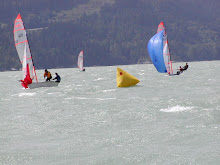After bonding the two layers of carbon to the hull and deck, we noticed a definite uniform increase in strength and decrease in flex. Next we shaped our cross-supports with a small saw and by hand-sanding.
.jpg)
 Next, we glued them in place, using a generous bead across the contact edge. This could be thickened epoxy, or a specialty glue like spabond, epibond, plexus, etc.
Next, we glued them in place, using a generous bead across the contact edge. This could be thickened epoxy, or a specialty glue like spabond, epibond, plexus, etc. Problems:
I can see already that swinging the whisker pole around on a windy race day could damage these frames. Also, the materials are of no matter. Fiberglass, carbon, or wood, polyester or epoxy should make little difference in weight or result for this application. Wood and epoxy could be all you need to get this done. I saw a successful result made from g-10 plastic bonded with some fiberglass. I think our materials may be hard to come by and fragile. However, take some time in building no matter the material. Our focus was not on exact measurement, but attention to quality in the preparation, gluing and laminating processes. Strength and durability over look.
Measurement: I'll forward the measurements to anybody who asks, but it was simply a matter of even spacing, and seating position. We used three supports. One in front but near the jib cleat for the crew. Another positioned at the aft end of the centerboard trunk, and one in between.
Rudder update:
Construction method is pre-preg from a female mold. construction has begun, more to follow...






